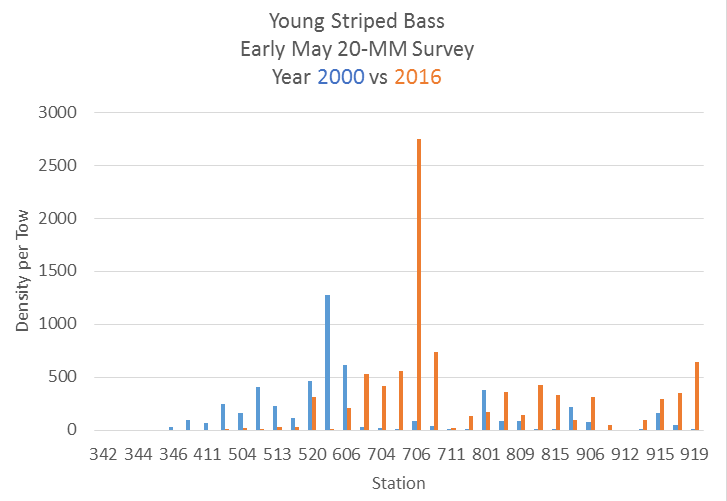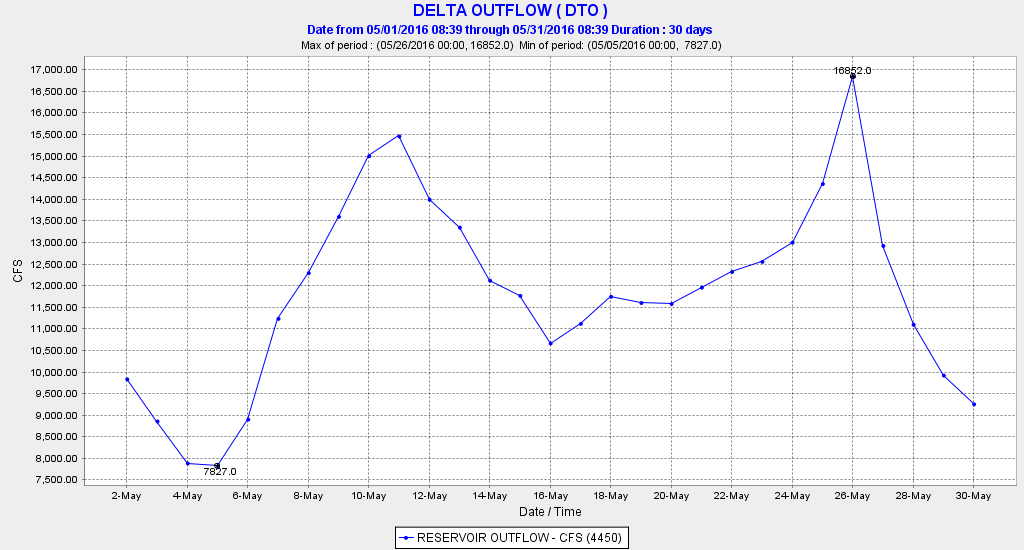The striped bass 2016 year class production continues looking good compared to past years, even the last modest production year 2000. Year 2000 was the last year the Summer Townet Index for striped bass reached 5. On May 28 I related the unusually high April catches of larval striped bass in the 20-mm Survey. The most recent survey in May continues this trend. A comparison of May 20-mm Survey catches in 2000 vs 2016 (Chart 1) provides some insight as to really how remarkable the 2016 pattern really is.
Year 2000 was a wet year with early May Delta outflows of 30,000-36,000 cfs, whereas early May 2016, a below-normal water year, had only 8,000-15,000 cfs Delta outflow. The distributions of larval stripers in Chart 1 reflect the differences in outflow, with larval striped bass being more concentrated in Suisun Bay (stations 400s and 500s) in year 2000, as compared with the higher concentrations being in the Delta (stations 700s, 800s, and 900s) in 2016.
The larval striped bass densities in the Delta in 2016 are relatively high compared to the past 10 years, and they are comparable to the 10 years before that (1995-2005). The high spring larval densities are coincident with moderate Delta inflow/outflow and low exports, along with a rare spring plankton bloom.
The prognosis for the 2016 striped bass year class remains poor, for the same reason striped bass and other Delta fishes have suffered over the past four decades: upcoming low summer Delta outflows and high exports. Most of larvae in the central, southern, and eastern Delta (stations in the 800s and 900s in Chart 1) will not survive. Few young striped bass will reach the sanctuary of Suisun Bay (stations in the 400s and 500s).
This pattern is ominously similar for Delta smelt. The success of both Delta smelt and striped bass in 2016 will be a function of how many can reach Suisun Bay and how they will fare in Suisun Bay. With expected low summer outflows and high exports, Suisun Bay may be too brackish for both species, in which case survivors will be forced to survive the summer in the lower Sacramento River channel in the north and western Delta (station 700s). Even here, remaining smelt and striped bass will be continually siphoned off from net negative tidal flows through Three Mile Slough to the central and south Delta. So goes the Delta over the past four decades.
In an April 27 post, I recommended maintaining a June Delta outflow of 15,000 cfs to help recover longfin smelt. Maintaining outflow in the 10,000-15,000 range through June would also help Delta smelt and striped bass by keeping the Low Salinity Zone nursery of all three species in Suisun Bay away from the influence of the South Delta exports. Such outflows were maintained in 2010, the last below-normal water year. With expected exports in June of about 5000 cfs (BO limit for OMR), an outflow of at least 10,000 cfs could be achieved under the existing Export/Inflow standard of 35%. With end-of-May Delta outflow already falling below 10,000 cfs (Chart 2), the issue should be addressed immediately by the agencies’ Smelt Working Group and Delta Management Group.


